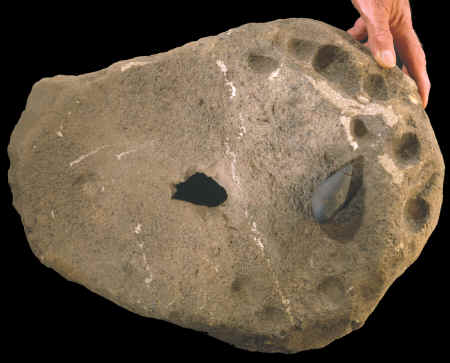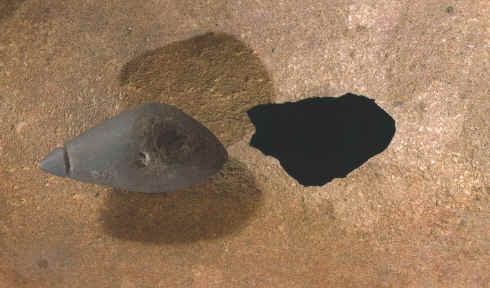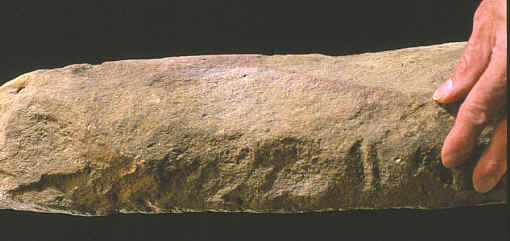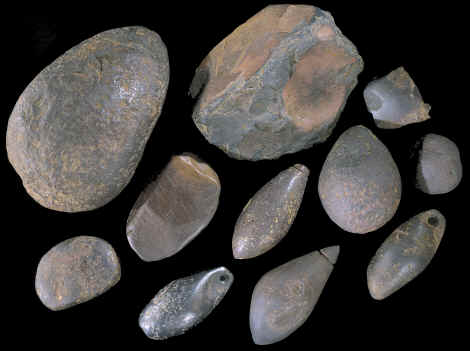|
PAGE
2 CONTINUED
FROM PAGE 1
PLUMMET
& RED OCHRE
GRINDING STONE
MID
WOODLAND PERIOD
ST.
CHARLES CO., MISSOURI
EST. 100 B.C.
TO A.D. 450
PAGE 2 OF
3 PAGES
COPYRIGHT
JULY 31, 2003 PETER A. BOSTROM

CLICK ON PICTURE FOR LARGE IMAGE
BOTTOM VIEW OF LARGE
GRINDING STONE
ST. CHARLES CO.,
MISSOURI AND SOUTHERN ILLINOIS
PRIVATE
COLLECTION
This picture shows the underside of this large sandstone grinding stone.
Notice the hole
worn through in the center. There are also at
least 15 shallow holes located around the edges that may have been used for the manufacture of plummets
or maybe just cracking nuts. Since there is no obvious red
ochre staining on this side it may not have been used to grind
hematite. This surface may have been used to process other
materials such as seeds or nuts. The general shape of
this side is slightly concave. |
|
|
The reason that not many grinding stones of this size have been
found on Stone Age sites in the Mississippi Valley region may be
because they were simply used up. As the large grinders broke apart
from use, the smaller pieces would also have been used for small hand-held
abraders. Even a later culture would have used a large piece of
sandstone if a grinder was found abandoned by the previous culture. This grinding stone
measures 18 inches (45.7 cm) long, 13 1/2 inches (34.2 cm) wide and
5 inches (12.7 cm) thick. It weighs 33 pounds (15 kg). |
|

CLICK ON PICTURE FOR LARGE IMAGE
HOLE
WORN THROUGH GRINDING CAVITY
ST. CHARLES CO.,
MISSOURI
PRIVATE
COLLECTION
This picture shows the hole that wore through the bottom of
the grinding cavity indicating that this grinding stone was
heavily used and was nearing the end its usefulness. Notice
the heavy red ochre staining on the surface of the grinding
cavity that was caused by grinding hematite. |
|
|
This grinding stone is heavily stained with red ochre. The red
pigment is coating the walls of the deep grinding cavity. The opposite side doesn't
show any of this red staining and may have been used for some other
purpose such as food processing. The overall surface is generally
concave. |
|

|
|
EDGE
VIEW OF HEMATITE GRINDING STONE
ST. CHARLES CO.,
MISSOURI
PRIVATE
COLLECTION
This picture shows the edge profile of this large sandstone
grinding stone from St. Charles County, Missouri. It measures
5
inches (12.7 cm) thick. |
|
|
The grinding cavity on the side that was used to grind hematite is fairly deep.
The depth of the depression is 3 inches (7.6 cm). Grinding continued
until a hole developed on the bottom from wear. This tool was
nearing the end of its usefulness as a large grinding stone. Had it
been used much long it would most probably have begun to break up.
The hole measures 2 inches (5 cm) across. |
|

CLICK ON PICTURE FOR LARGE IMAGE
HEMATITE ARTIFACTS
ST. CHARLES CO.,
MISSOURI AND SOUTHERN ILLINOIS
PRIVATE
COLLECTION
These hematite artifacts illustrate both raw pieces, preforms
("blanks") and finished examples that have been
found on Archaic and Woodland sites in Illinois and Missouri.
The finished artifacts are in the form of one hemisphere, four
plummets and the piece at top right that appears to be a
polished fragment of an axe. The two large tear-drop shaped
pieces are plummet preforms which are usually referred to as
"blanks." The irregular piece at top center shows
altered surfaces that were polished and scratched plus edges
that were pounded.
The two perforated plummets are called Godar plummets and date
to the Archaic period. The plummet in the bottom row with the
groove and pointed base is called a Snyders Grooved plummet.
They were being made during the Middle to Late Woodland
period. The other grooved plummet has a groove near its
flattened styled base. This variety is called a Gilcrease
Grooved plummet and dates to the Archaic period.
It is interesting that most hematite artifacts are still
rather enigmatic. They were made into the shapes of cones,
hemispheres and plummets. None of these artifacts have
absolute use definitions proven by science. It is speculated
that plummets were used as bolas. There are also some
suggestions that they were used as net weights. One of the few
obvious hematite tool forms are the axes that were made from
this material. |
|
|
There are at least 23 small depressions around the edges of both sides of
this grinding stone. They are typically seen on most sandstone tools of
this size and may have been used to crack nuts. None of the small holes
contain the heavy red ochre staining that the large grinding cavity has.
So it's reasonable to speculate that they may not have been used for the
manufacture of plummets.
|